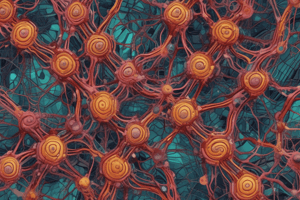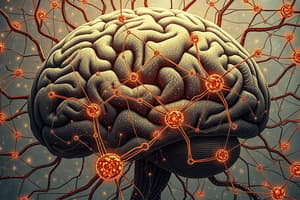Podcast
Questions and Answers
What uniquely enables a Recurrent Neural Network (RNN) to handle sequential data effectively?
What uniquely enables a Recurrent Neural Network (RNN) to handle sequential data effectively?
- Uses a static architecture for all input types
- Utilizes nonlinear activation functions to transform inputs
- Incorporates loops to maintain information over time (correct)
- Processes data in parallel across all layers
Which neural network architecture is primarily used for processing and analyzing image data?
Which neural network architecture is primarily used for processing and analyzing image data?
- Long Short-Term Memory (LSTM)
- Recurrent Neural Network (RNN)
- Convolutional Neural Network (CNN) (correct)
- Generative Adversarial Network (GAN)
Which evaluation metric focuses on the balance between true positives and overall predicted positives?
Which evaluation metric focuses on the balance between true positives and overall predicted positives?
- F1 Score
- Accuracy
- Recall
- Precision (correct)
What distinguishes the Long Short-Term Memory (LSTM) network from a standard Recurrent Neural Network (RNN)?
What distinguishes the Long Short-Term Memory (LSTM) network from a standard Recurrent Neural Network (RNN)?
In the context of AI applications, which of the following is NOT typically associated with Natural Language Processing (NLP)?
In the context of AI applications, which of the following is NOT typically associated with Natural Language Processing (NLP)?
What is a potential drawback of using complex models like deep neural networks compared to simpler models like linear regression?
What is a potential drawback of using complex models like deep neural networks compared to simpler models like linear regression?
Which training technique involves adjusting learning rates during the training process to enhance convergence?
Which training technique involves adjusting learning rates during the training process to enhance convergence?
How does dropout function as a training technique?
How does dropout function as a training technique?
What distinguishes transfer learning from traditional machine learning approaches?
What distinguishes transfer learning from traditional machine learning approaches?
Which architecture type is generally easier to interpret?
Which architecture type is generally easier to interpret?
Flashcards are hidden until you start studying
Study Notes
Neural Networks Study Notes
Architecture Types
-
Feedforward Neural Network
- Information moves in one direction: input to output.
- Nodes are organized in layers (input, hidden, output).
-
Convolutional Neural Network (CNN)
- Primarily used for image processing.
- Employs convolutional layers to capture spatial hierarchies.
-
Recurrent Neural Network (RNN)
- Designed for sequential data (e.g., time series, text).
- Incorporates loops to maintain information over time.
-
Long Short-Term Memory (LSTM)
- A type of RNN that addresses the vanishing gradient problem.
- Capable of learning long-term dependencies.
-
Generative Adversarial Network (GAN)
- Comprises two networks: generator and discriminator.
- Used for generating realistic data samples.
Applications In AI
-
Image Recognition
- Used in facial recognition, object detection, and autonomous vehicles.
-
Natural Language Processing (NLP)
- Powers applications like translation, sentiment analysis, and chatbots.
-
Speech Recognition
- Converts spoken language into text, used in virtual assistants.
-
Game Playing
- AI models train to play games (e.g., AlphaGo) using reinforcement learning.
-
Healthcare
- Assists in diagnostics, medical image analysis, and personalized medicine.
Model Evaluation
-
Metrics
- Accuracy: Proportion of correct predictions.
- Precision: Ratio of true positives to predicted positives.
- Recall: Ratio of true positives to actual positives.
- F1 Score: Harmonic mean of precision and recall.
-
Validation Techniques
- Train/Test Split: Divides data into separate subsets for training and testing.
- Cross-Validation: Splits data into k subsets to ensure robust evaluation.
-
Overfitting vs Underfitting
- Overfitting: Model learns noise in training data, performs poorly on unseen data.
- Underfitting: Model is too simplistic to capture underlying patterns.
Comparative Analysis
-
Model Complexity
- Evaluate trade-offs between simple models (e.g., linear regression) vs. complex models (e.g., deep neural networks).
-
Generalization Ability
- Assess how well models perform on unseen data, focusing on overfitting and robustness.
-
Training Time and Resources
- Compare computational requirements and time taken for training various architectures.
-
Interpretability
- Simpler models are often easier to interpret than complex neural networks.
Training Techniques
-
Backpropagation
- Algorithm for training neural networks by calculating gradients and updating weights.
-
Batch Normalization
- Normalizes inputs of each layer to stabilize training and improve convergence speed.
-
Dropout
- Regularization technique to prevent overfitting by randomly deactivating nodes during training.
-
Learning Rate Scheduling
- Adjusts the learning rate during training to improve convergence.
-
Transfer Learning
- Utilizes pre-trained models on new tasks to reduce training time and enhance performance.
Architecture Types
- Feedforward Neural Network:
- Unidirectional information flow from input to output, organized into layers (input, hidden, output).
- Convolutional Neural Network (CNN):
- Specifically designed for image processing, uses convolutional layers to identify spatial hierarchies.
- Recurrent Neural Network (RNN):
- Tailored for sequential data like time series and text, features loops for memory retention across sequences.
- Long Short-Term Memory (LSTM):
- Advanced RNN variant that overcomes the vanishing gradient issue, enabling the learning of long-term dependencies.
- Generative Adversarial Network (GAN):
- Comprises two competing networks, a generator and a discriminator, utilized for creating realistic data samples.
Applications In AI
- Image Recognition:
- Applied in facial recognition systems, object detection, and self-driving vehicle technology.
- Natural Language Processing (NLP):
- Drives functionalities such as language translation, sentiment analysis, and chatbot interactions.
- Speech Recognition:
- Transforms spoken language into text, essential for virtual assistant technologies.
- Game Playing:
- AI models learn to play games (e.g., AlphaGo) using reinforcement learning techniques.
- Healthcare:
- Supports diagnostic processes, medical imaging analysis, and personalized treatment strategies.
Model Evaluation
- Metrics for Evaluation:
- Accuracy: Measures the proportion of correct predictions made by the model.
- Precision: Indicator of true positives relative to the total positive predictions.
- Recall: Ratio of true positives to actual positives, emphasizing the model's ability to identify all relevant instances.
- F1 Score: Combines precision and recall into a single metric via the harmonic mean.
- Validation Techniques:
- Train/Test Split: Segregates data into distinct subsets for training and evaluation.
- Cross-Validation: Divides data into k subsets for more reliable model assessment.
- Overfitting vs Underfitting:
- Overfitting: Occurs when a model learns training data noise, reducing performance on new data.
- Underfitting: Happens when a model fails to capture important data patterns due to excessive simplicity.
Comparative Analysis
- Model Complexity:
- Balance between simpler models (e.g., linear regression) and more complex deep neural networks.
- Generalization Ability:
- Evaluates model performance on unseen data, addressing concerns of overfitting and robustness.
- Training Time and Resources:
- Compares the computation demand and duration required for training various neural network architectures.
- Interpretability:
- Simpler models typically offer greater interpretability compared to intricate neural network configurations.
Training Techniques
- Backpropagation:
- A key algorithm for adjusting weights in neural networks by computing gradients.
- Batch Normalization:
- Normalizes layer inputs to stabilize the training process and enhance convergence rates.
- Dropout:
- A form of regularization that combats overfitting by randomly disabling nodes during training cycles.
- Learning Rate Scheduling:
- Dynamically adjusts the learning rate throughout training to optimize convergence.
- Transfer Learning:
- Leverages pre-trained models on new tasks to accelerate training and boost performance outcomes.
Studying That Suits You
Use AI to generate personalized quizzes and flashcards to suit your learning preferences.




